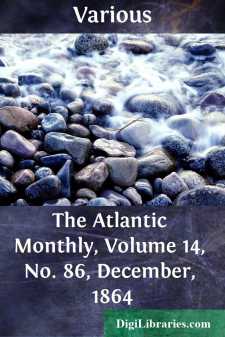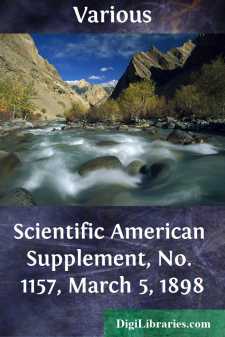Categories
- Antiques & Collectibles 13
- Architecture 36
- Art 48
- Bibles 22
- Biography & Autobiography 813
- Body, Mind & Spirit 142
- Business & Economics 28
- Children's Books 17
- Children's Fiction 14
- Computers 4
- Cooking 94
- Crafts & Hobbies 4
- Drama 346
- Education 46
- Family & Relationships 57
- Fiction 11829
- Games 19
- Gardening 17
- Health & Fitness 34
- History 1377
- House & Home 1
- Humor 147
- Juvenile Fiction 1873
- Juvenile Nonfiction 202
- Language Arts & Disciplines 88
- Law 16
- Literary Collections 686
- Literary Criticism 179
- Mathematics 13
- Medical 41
- Music 40
- Nature 179
- Non-Classifiable 1768
- Performing Arts 7
- Periodicals 1453
- Philosophy 64
- Photography 2
- Poetry 896
- Political Science 203
- Psychology 42
- Reference 154
- Religion 513
- Science 126
- Self-Help 84
- Social Science 81
- Sports & Recreation 34
- Study Aids 3
- Technology & Engineering 59
- Transportation 23
- Travel 463
- True Crime 29
The Atlantic Monthly, Volume 14, No. 86, December, 1864
by: Various
Categories:
Description:
Excerpt
THE HIGHLAND LIGHT.
This light-house, known to mariners as the Cape Cod or Highland Light, is one of our "primary sea-coast lights," and is usually the first seen by those approaching the entrance of Massachusetts Bay from Europe. It is forty-three miles from Cape Ann Light, and forty-one from Boston Light. It stands about twenty rods from the edge of the bank, which is here formed of clay. I borrowed the plane and square, level and dividers, of a carpenter who was shingling a barn near by, and, using one of those shingles made of a mast, contrived a rude sort of quadrant, with pins for sights and pivots, and got the angle of elevation of the bank opposite the light-house, and with a couple of cod-lines the length of its slope, and so measured its height on the shingle. It rises one hundred and ten feet above its immediate base, or about one hundred and twenty-three feet above mean low water. Graham, who has carefully surveyed the extremity of the Cape, makes it one hundred and thirty feet. The mixed sand and clay lay at an angle of forty degrees with the horizon, where I measured it, but the clay is generally much steeper. No cow nor hen ever gets down it. Half a mile farther south the bank is fifteen or twenty-five feet higher, and that appeared to be the highest land in North Truro. Even this vast clay-bank is fast wearing away. Small streams of water trickling down it at intervals of two or three rods have left the intermediate clay in the form of steep Gothic roofs fifty feet high or more, the ridges as sharp and rugged-looking as rocks; and in one place the bank is curiously eaten out in the form of a large semicircular crater.
According to the light-house keeper, the Cape is wasting here on both sides, though most on the eastern. In some places it had lost many rods within the last year, and erelong the light-house must be moved. We calculated, from his data, how soon the Cape would be quite worn away at this point,—"for," said he, "I can remember sixty years back." We were even more surprised at this last announcement—that is, at the slow waste of life and energy in our informant, for we had taken him to be not more than forty—than at the rapid wasting of the Cape, and we thought that he stood a fair chance to outlive the former.
Between this October and June of the next year I found that the bank had lost about forty feet in one place opposite the light-house, and it was cracked more than forty feet farther from the edge at the last date, the shore being strewn with the recent rubbish. But I judged that generally it was not wearing away here at the rate of more than six feet annually. Any conclusions drawn from the observations of a few years or one generation only are likely to prove false, and the Cape may balk expectation by its durability. In some places even a wrecker's foot-path down the bank lasts several years. One old inhabitant told us that when the light-house was built, in 1798, it was calculated that it would stand forty-five years, allowing the bank to waste one length of fence each year, "but," said he, "there it is" (or rather another near the same site, about twenty rods from the edge of the bank).
The sea is not gaining on the Cape everywhere: for one man told me of a vessel wrecked long ago on the north of Provincetown whose "bones" (this was his word) are still visible many rods within the present line of the beach, half buried in sand. Perchance they lie along-side the timbers of a whale. The general statement of the inhabitants is, that the Cape is wasting on both sides, but extending itself on particular points on the south and west, as at Chatham and Monomoy Beaches, and at Billingsgate, Long, and Race Points. James Freeman stated in his day that above three miles had been added to Monomoy Beach during the previous fifty years, and it is said to be still extending as fast as ever. A writer in the "Massachusetts Magazine," in the last century, tells us, that, "when the English first settled upon the Cape, there was an island off Chatham, at three leagues' distance, called Webb's Island, containing twenty acres, covered with red-cedar or savin. The inhabitants of Nantucket used to carry wood from it"; but he adds that in his day a large rock alone marked the spot, and the water was six fathoms deep there. The entrance to Nauset Harbor, which was once in Eastham, has now travelled south into Orleans. The islands in Wellfleet Harbor once formed a continuous beach, though now small vessels pass between them. And so of many other parts of this coast.
Perhaps what the ocean takes from one part of the Cape it gives to another,—robs Peter to pay Paul. On the eastern side the sea appears to be everywhere encroaching on the land. Not only the land is undermined, and its ruins carried off by currents, but the sand is blown from the beach directly up the steep bank, where it is one hundred and fifty feet high, and covers the original surface there many feet deep. If you sit on the edge, you will have ocular demonstration of this by soon getting your eyes full. Thus the bank preserves its height as fast as it is worn away. This sand is steadily travelling westward at a rapid rate, "more than a hundred yards," says one writer, within the memory of inhabitants now living; so that in some places peat-meadows are buried deep under the sand, and the peat is cut through it; and in one place a large peat-meadow has made its appearance on the shore in the bank covered many feet deep, and peat has been cut there....












